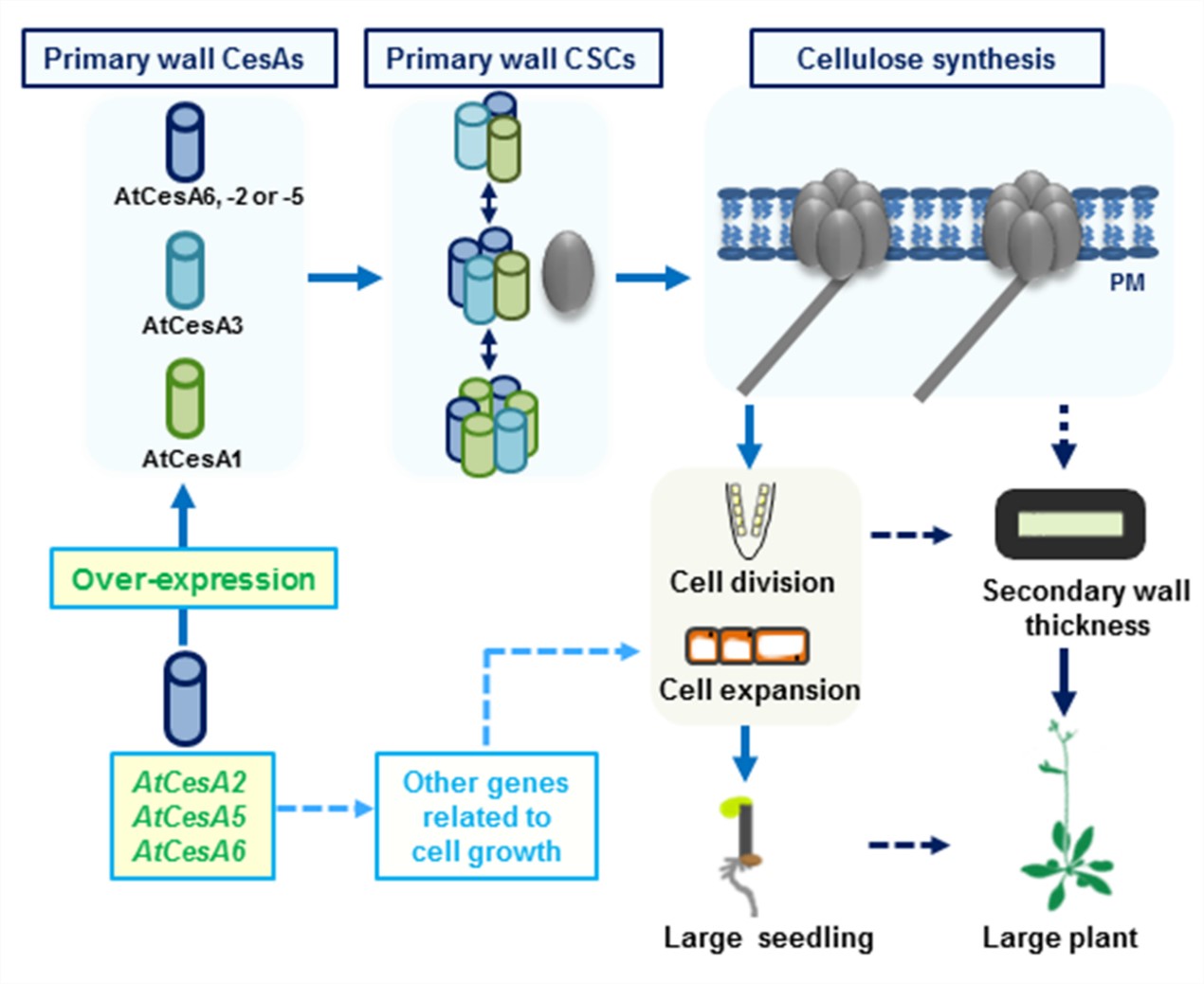Plant Biotechnol J. | 华中农业大学生物质能课题组解析纤维素合酶影响植物生长新机制
植物科学最前沿
近日,Plant Biotechnology Journal在线发表了华中农业大学生物质与生物能源中心彭良才教授课题组题为“Three AtCesA6-like members enhance biomass production by distinctively promoting cell growth in Arabidopsis”的研究论文。该研究对模式植物拟南芥的纤维素合酶(CesA)家族基因进行了系统地研究,首次成功地通过超表达特定的AtCesA基因促进了纤维素合成和生物量积累,进一步揭示了初生细胞壁影响植物发育的机理,并从细胞伸长和细胞分裂着手,提出了促进细胞生长和次生壁积累的新思路,为植物生物量的遗传改良提供了理论依据。

Figure 9 A hypothetical model of how over-expression of three AtCesA6-like genes affect plant growth for biomass production.
植物细胞壁决定了植物细胞的形态和大小,为植物提供机械支撑和保护,并参与信号转导、信息传递和多种生理生化代谢。细胞壁包含初生壁和次生壁;初生壁在细胞分裂和伸长时期合成,具有柔软性和可塑性,对细胞大小有着决定性的作用;次生壁在细胞伸长停止时开始在初生壁内侧沉积,是植物机械支撑力和生物量的重要因子。
纤维素是植物细胞壁的主要成分,亦是地球上含量最多的生物质。在高等植物中,纤维素由CesA复合体直接合成。自1998年高等植物第一个CesA基因AtCesA1被彭良才等人发现以来,多个实验室通过反向遗传学手段,在植物中同源或异源超表达次生壁CesA基因来提高纤维素含量和植物生物量,但鲜有成功的报道。
本研究系统分析了初生壁和次生壁CesA对植物生长发育的影响。结果表明,在超表达拟南芥的整个CesA家族基因时,只有特定的三个初生壁AtCesA6-like基因(AtCesA2, -5, -6)能够促进整个初生壁AtCesA基因的表达,加快初生壁CesA复合体在原生质膜上的运动速率,增加纤维素宏纤丝体外重聚颗粒大小,从而提高初生壁纤维素含量。初生壁纤维素的增加促进了细胞伸长和分裂,并影响与植物生长相关的基因表达,最终促进幼苗生长。值得关注的是,初生壁合成的增强进一步促进了次生壁沉积,增强了茎秆机械强度,从而显著促进了植物生长和生物量积累。而初生壁对次生壁的影响也是近年来的研究热点,本结果也将有助于这一热点的深入研究。
该论文以华中农业大学为第一完成单位,博士生胡慧贞为论文第一作者,彭良才教授为通讯作者。澳大利亚墨尔本大学Staffan Persson研究组和美国密西根州立大学丁士友教授也参与了本研究。该研究得到了国家自然科学基金委、国家科技部、国家外国专家局与教育部的资助。

Three AtCesA6-like members enhance biomass production by distinctively promoting cell growth in Arabidopsis
Huizhen Hu, Ran Zhang, Shengqiu Feng, Youmei Wang, Yanting Wang, Chunfen Fan, Ying Li, Zengyu Liu, René Schneider, Tao Xia, Shi-You Ding, Staffan Persson and Liangcai Peng
Cellulose is an abundant biopolymer and a prominent constituent of plant cell walls. Cellulose is also a central component to plant morphogenesis and contributes the bulk of a plant’s biomass. While cellulose synthase (CesA) genes were identified over two decades ago, genetic manipulation of this family to enhance cellulose production has remained difficult. In this study, we show that increasing the expression levels of the three primary cell wall AtCesA6-like genes (AtCesA2, -5, -6), but not AtCesA3, AtCesA9 or secondary cell wall AtCesA7, can promote the expression of major primary wall CesA genes to accelerate primary wall CesA complex (CSCs) particle movement for acquiring long microfibrils and consequently increasing cellulose production in Arabidopsis transgenic lines, as compared with wild type. The over-expression transgenic lines displayed changes in expression of genes related to cell growth and proliferation, perhaps explaining the enhanced growth of the transgenic seedlings. Notably, over-expression of the three AtCesA6-like genes also enhanced secondary cell wall deposition that led to improved mechanical strength and higher biomass production in transgenic mature plants. Hence, we propose that over-expression of certain AtCesA genes can provide a biotechnological approach to increase cellulose synthesis and biomass accumulation in transgenic plants.